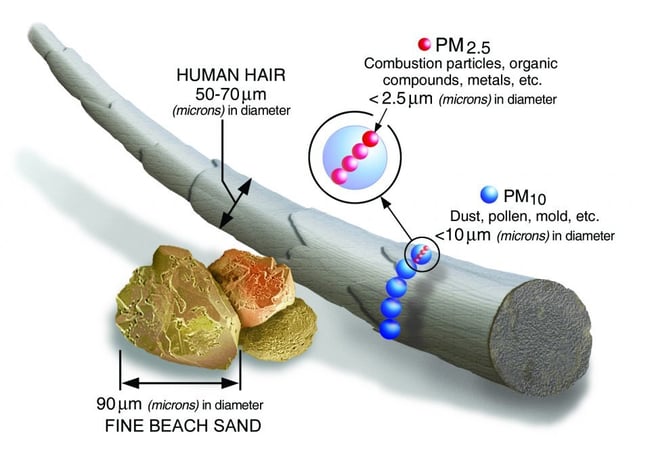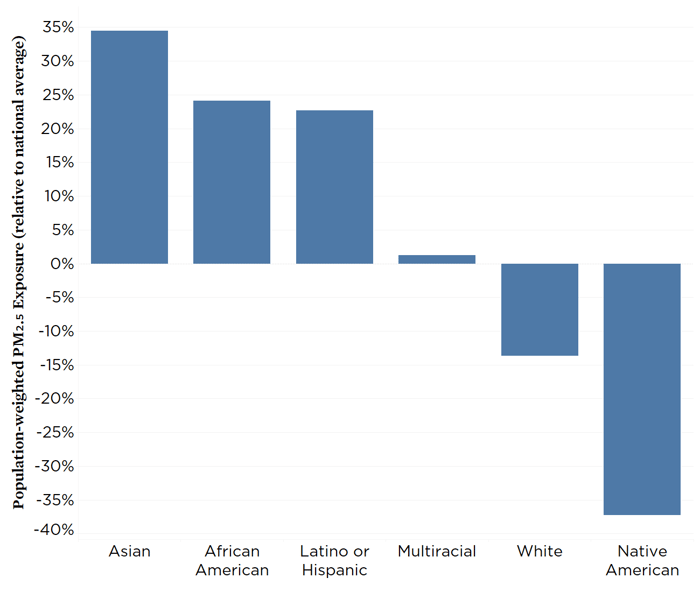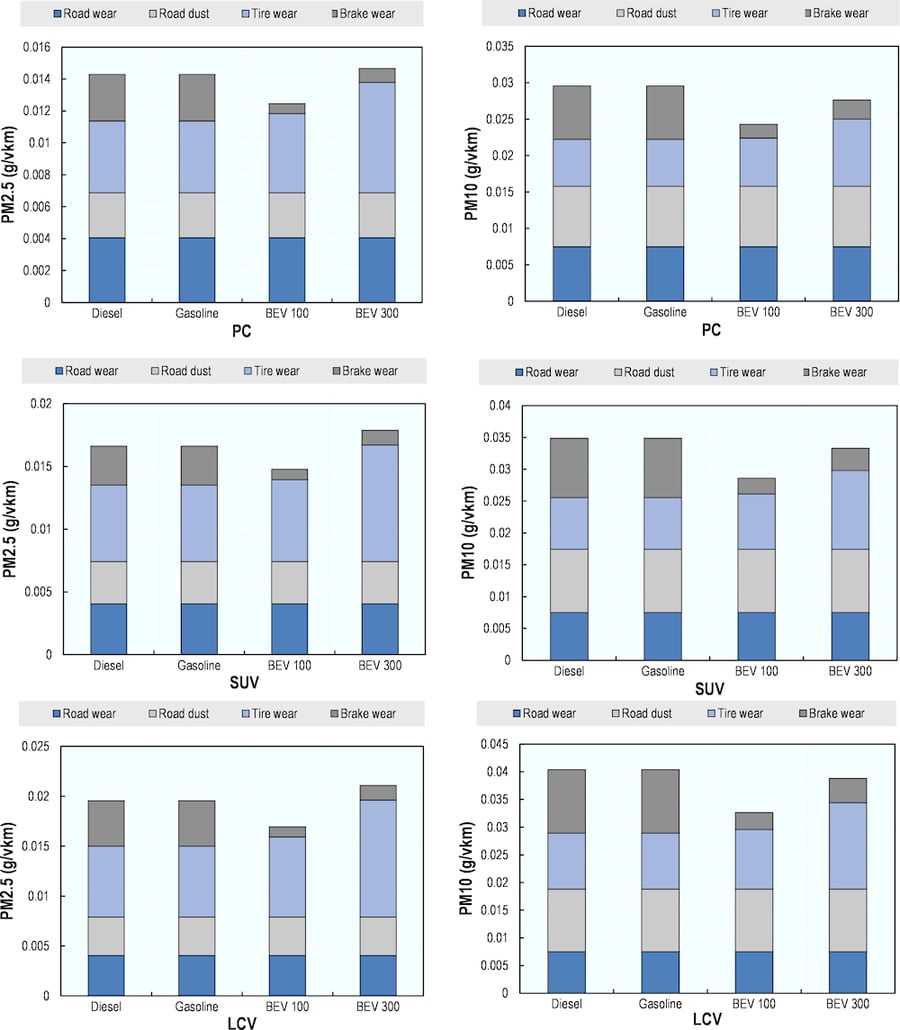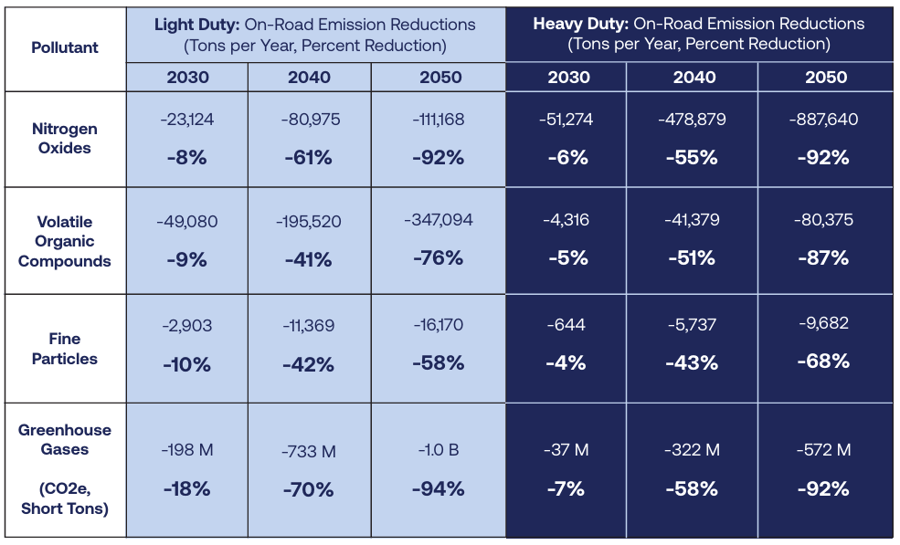Guest Blogpost: Mass Fleet Advisor
Note: At Green Energy Consumers, we know that we need to rapidly electrify all forms of transportation –...
andCaitlyn Rodriguez
andCaitlyn Rodriguez
We talk about electric vehicles (EVs) from a climate and consumer perspective all the time, but in honor of World Asthma Day, we’ve done a deep dive into particulate matter (PM) emissions, their impact on public health, and how EVs have lower rates of PM emissions when you look at both exhaust and non-exhaust sources.
Particulate matter, or PM, refers to tiny, airborne particles that come from the combustion of gasoline and diesel fuel, wear and tear of tires, brake pads, brake disks, and the surface of the road. These particles are generally classified by size, and in this blog, we’ll be talking about PM2.5 (smaller than 2.5 micrometers) and PM10 (smaller than 10 micrometers). Both are significantly smaller than the width of a human hair, and PM is not visible to the human eye.

Lots of different processes produce particulate matter. Vehicles produce PM in two main ways:
The introduction of catalytic converters and other technologies has dramatically reduced exhaust PM emissions from vehicles in the past several decades (at this point, more PM emissions from non-exhaust sources than from exhaust pipes). According to this Science Direct article, over 90% of PM10 and 85% of PM2.5 are from non-exhaust sources.
Medium- and heavy-duty diesel vehicles are disproportionately polluting. In Massachusetts, for example, only 7% of the vehicles on the road are medium- and heavy-duty trucks, but they contribute 40% of transportation PM emissions.
Since PM particles are microscopic, they penetrate the lungs and the bloodstream, causing or exacerbating asthma, heart and lung diseases, cancers, cognitive disorders, and low birth weights.
This pollution – and the corresponding health impacts – disproportionately burden communities of color. A report from the Union of Concerned Scientists reveals that Asian, Latino, and African American people are exposed to greater levels of PM2.5 from cars, trucks, and buses when compared to the average level of exposure for the whole U.S. population, whereas white Americans and Native Americans are exposed to lower levels. (The lower average exposure of Native Americans “reflects communities that are in rural areas with lower concentration of vehicle traffic” (UCS).)

Source: Union of Concerned Scientists - Air Pollution from Cars, Trucks, and Buses in the US
The heavier a vehicle, the more wear and tear on the tires and brakes, and therefore, in general, the more PM. EVs are generally heavier than comparable internal combustion vehicles because of the batteries (an electric sedan is heavier than a gas sedan, for example), so many folks assume that they are also responsible for more PM emissions. However, the data tells a different story.
Non-Exhaust Emissions
The Organization for Economic Co-operation and Development (OECD) wrote a report in December 2020 that compares non-exhaust PM emissions from internal combustion engine (ICE) vehicles and battery-electric vehicles (BEV). More specifically, the OECD study considers two types of PM (PM2.5 and PM10) across four vehicle types: diesel-powered cars, gas-powered cars, and two BEVs – a smaller BEV with a range of 100 kilometers (km) and a larger BEV with a range of 300 km.
OECD’s study finds that BEVs emit less non-exhaust PM10 than ICE vehicles, but that longer-range BEVs emit slightly more non-exhaust PM2.5. The graph below summarizes these findings and digs into differences between road wear, road dust, tire wear, and brake wear. You’ll note that:

ICEV and BEV non-exhaust PM emission factors by vehicle class PM2.5 (left) and PM10 (right). Source: OECD.
The same OECD report summarizes the impact of BEV passenger cars (PC), SUVs, and light commercial vehicles (LCVs) compared to gasoline versions. The table below demonstrates lower PM emissions for BEVs in every category except PM2.5 emission from 300 km BEVs.

Source: OECD
Exhaust Emissions
The analysis above only considers non-exhaust PM emissions. But that, of course, is not the whole picture! The same OECD study also lists exhaust PM2.5 and PM10 emissions from passenger cars, SUVs, and light-duty commercial vehicles. When we added those to the non-exhaust emissions and create the following graphs, you can see that total PM emissions (non-exhaust + exhaust) are lower for both PM2.5 and PM10 for BEVs than their gas-powered counterparts in every vehicle category.

Total emissions from vehicles (non-exhaust colors are meant to differentiate the categories), visualized from OECD data
All the analysis we did above comes from the OECD study. But we’re not public health experts. Luckily, we have the American Lung Association (ALA), and they report on the relationship between a widespread transition to zero-emission vehicles and air quality, public health, and climate benefits to the United States. In their Zeroing in on Healthy Air report, ALA finds that shifting to 100% of new vehicle sales being electric by 2035 and 100% of new medium- and heavy-duty vehicle sales being electric by 2040 nationally, along with renewable electricity, would reduce fine particle pollution by double-digit percentages:

Source: ALA
In 2030 alone, the health benefits tally up to $28 billion.
Meanwhile, ALA’s recent State of the Air report shows that nearly half of Americans live in places with failing grades for unsafe air, and that air quality in our region has been getting worse in recent years.
So, in honor of World Asthma Day, if you need a car to get around, we’re here to help you make it electric.
P.S. We have a current urgent action alert to defend clean car regulations in Massachusetts. Learn more and take action here.
P.P.S. Clean Water Action is hosting a World Asthma Day event today from 4:00 to 6:00 p.m. at Maverick Landing (31 Liverpool Street) in East Boston. We will be there – Join us to rally for clean air!
Note: At Green Energy Consumers, we know that we need to rapidly electrify all forms of transportation –...
andCaitlyn Rodriguez
The Massachusetts Department of Energy Resources (DOER)...
andCaitlyn Rodriguez
Comments